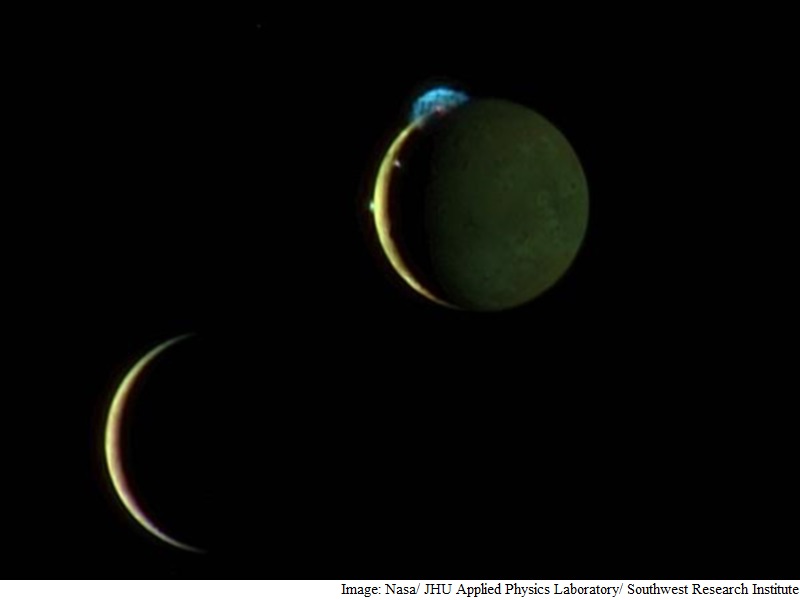- Home
- Science
- Science News
- Underground Magma Ocean Could Explain Io's Misplaced Volcanoes
Underground Magma Ocean Could Explain Io's Misplaced Volcanoes

It implies that oceans beneath the crusts of tidally stressed moons may be more common and last longer than expected.
The phenomenon applies to oceans made from either magma or water, potentially increasing the odds for life elsewhere in the universe.
Io is the most volcanically active world in the solar system, with hundreds of erupting volcanoes blasting fountains of lava up to about 400 kms high.
"This is the first time the amount and distribution of heat produced by fluid tides in a subterranean magma ocean on Io has been studied in detail," said Robert Tyler from the University of Maryland-College Park and Nasa's Goddard Space Flight Center in Greenbelt, Maryland.
"We found that the pattern of tidal heating predicted by our fluid-tide model is able to produce the surface heat patterns that are actually observed on Io," he added.
The intense geological activity at Io is the result of heat produced by a gravitational tug-of-war between Jupiter's massive gravity and other smaller but precisely timed pulls from Europa, a neighbouring moon that orbits further from Jupiter.
Io orbits faster, completing two orbits every time Europa finishes one.
This regular timing means that Io feels the strongest gravitational pull from its neighbour in the same orbital location, which distorts Io's orbit into an oval shape.
The new work also has implications for the search for extraterrestrial life.
Scientists think life might originate in such oceans if they have other key ingredients thought to be necessary, such as chemically available energy sources and raw materials.
The new work suggests that such subsurface oceans, whether composed of water or of any other liquid, will be more common and last longer than expected, both within our solar system and beyond.
The paper was published in the Astrophysical Journal Supplement Series.
Get your daily dose of tech news, reviews, and insights, in under 80 characters on Gadgets 360 Turbo. Connect with fellow tech lovers on our Forum. Follow us on X, Facebook, WhatsApp, Threads and Google News for instant updates. Catch all the action on our YouTube channel.
Related Stories
- Samsung Galaxy Unpacked 2025
- ChatGPT
- Redmi Note 14 Pro+
- iPhone 16
- Apple Vision Pro
- Oneplus 12
- OnePlus Nord CE 3 Lite 5G
- iPhone 13
- Xiaomi 14 Pro
- Oppo Find N3
- Tecno Spark Go (2023)
- Realme V30
- Best Phones Under 25000
- Samsung Galaxy S24 Series
- Cryptocurrency
- iQoo 12
- Samsung Galaxy S24 Ultra
- Giottus
- Samsung Galaxy Z Flip 5
- Apple 'Scary Fast'
- Housefull 5
- GoPro Hero 12 Black Review
- Invincible Season 2
- JioGlass
- HD Ready TV
- Laptop Under 50000
- Smartwatch Under 10000
- Latest Mobile Phones
- Compare Phones
- Redmi Note 15 5G
- Redmi Note 15 Pro 5G
- Redmi Note 15 Pro+ 5G
- Lava Play Max
- Poco C85 5G
- Honor Magic 8 Lite
- Jolla Phone
- Realme P4x 5G
- Asus ProArt P16
- MacBook Pro 14-inch (M5, 2025)
- OnePlus Pad Go 2
- Poco Pad M1
- Just Corseca Skywatch Pro
- Honor Watch X5
- Acerpure Nitro Z Series 100-inch QLED TV
- Samsung 43 Inch LED Ultra HD (4K) Smart TV (UA43UE81AFULXL)
- Asus ROG Ally
- Nintendo Switch Lite
- Haier 1.6 Ton 5 Star Inverter Split AC (HSU19G-MZAID5BN-INV)
- Haier 1.6 Ton 5 Star Inverter Split AC (HSU19G-MZAIM5BN-INV)

















